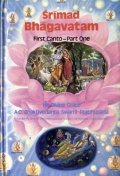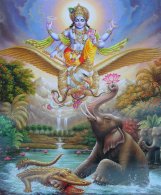So today is Lord Sri Caitanya Mahaprabhu’s appearance day. We will honor it with a full day fast, which we will break at the appearance of the full moon with a nice prasadam feast. Also in honor of this auspiscious day, we share with you a lecture given in Mayapur India, on the Gaura Purnima day, in 1976. Hare Krishna!
Śrīmad-Bhāgavatam Lecture 7.9.38
By His Divine Grace A. C. Bhaktivedanta Swami Prabhupāda
Māyāpur, March 16, 1976
Puṣṭa Kṛṣṇa: “In this way, my Lord, You have appeared in different incarnations—as human beings, as animals, as a great saintly person, as demigods and as a fish and a tortoise. In this way You maintain the whole creation in different planetary systems and kill the demoniac principles in every age. My Lord, You therefore protect the principles of religion. In the age of Kali You do not assert Yourself as the Supreme Personality of Godhead. Therefore You are known as Tri-yuga, or the Lord who appears in three yugas.”
Prabhupāda:
itthaṁ nṛ-tiryag-ṛṣi-deva-jhaṣāvatārair lokān vibhāvayasi haṁsi jagat pratīpān dharmaṁ mahā-puruṣa pāsi yugānuvṛttaṁ channaḥ kalau yad abhavas tri-yugo ’tha sa tvam
So here is a very specific statement about Śrī Caitanya Mahāprabhu, who is avatāra. Caitanya Mahāprabhu is the same Supreme Personality of Godhead, but He’s channa. Channa means covered, not directly, because He has appeared as a devotee. Avatāra… Rūpa Gosvāmī has found out that He’s avatāra of Kṛṣṇa. All the devotees, Sārvabhauma Bhaṭṭācārya, Rūpa Gosvāmī, and in the śāstra, and the Upaniṣad, Mahābhārata, in every… Sādhu-śāstra. Avatāra should be confirmed by great devotees, personalities, and must be collaborated with the statement in the śāstra.
So here is another statement in the Śrīmad-Bhgavatam. The directly, it is stated in the Elaeventh Canto, you know,
kṛṣṇa-varṇaṁ tviṣākṛṣṇaṁ sāṅgopāṅgāstra-pārṣadam yajñaiḥ saṅkīrtanaiḥ prāyair yajanti hi sumedhsaḥ [SB 11.5.32]
More


















